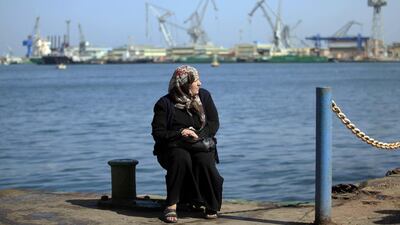The Suez Canal’s potential in the coming years will owe more to events on its surrounding land than on its waters.
The new 35-kilometre channel parallel to the original 193km canal, which officially opens today, as well as the deepening of 37km of channels through two lakes shave off up to a day in waiting and transit time for boats using the waterway.
This should ensure that Suez remains competitive with its main rival, the Panama Canal, for cargo travelling between the east coast of Asia and the east coast of North America.
But the number of ships expected to use either waterway, while growing, is limited in the best of times, and some of Suez’s advantage is almost certain to be eroded by an entirely new canal that China plans to begin building by the end of the year in Nicaragua, not far from Panama. This third canal is set to begin operating in 2020.
This is why it is important not to drop the ball on the matter of the less glamorous supporting infrastructure on the land around the Suez Canal. The real money to be made from the waterway is not from transit fees, but from a wide range of land-based services for the transiting ships.
The Suez Canal Authority expects earnings from the canal to increase to an annual US$13.2 billion in 2023 from the present $5bn. Tens of billions more could be made in logistics and industry.
For far too long, the Egyptian government has ignored the commercial potential of the land around the canal, through which about 8 per cent of all the world’s seaborne shipping passes. These ships carry goods worth perhaps $2 trillion a year, mainly between Asia and Europe.
Imagine one of the world’s biggest and busiest expressway interchanges with hardly a petrol station, a convenience store or even an exit ramp to be found.
The government under Hosni Mubarak belatedly began a series of initiatives in the late 1990s to exploit the location, including new ports and industrial zones at either end of the canal, but the work was slow, disjointed and often stifled by bureaucracy.
These included a 35 square km port at the northern end of the canal zone named East Port Said, which was designed partly as a transit hub for containers to be unloaded from giant cargo ships passing through the canal for distribution on smaller ships around the Mediterranean. Behind the port lies a separate, 40 sq km industrial zone.
Another Mubarak-era port, Sokhna at the canal’s southern end, has since become the main cargo port of Cairo, which lies 120km away via a purpose-built motorway. A 12 sq km industrial zone where factories already operate, including ammonia and fertilizer plants, lies nearby.
The government says it may spend up to $15bn on infrastructure, including electricity and water for irrigation, along the canal corridor.
Other new facilities, including container terminals and wet and dry bulk terminals, are also planned. Construction is set to begin next week of a small second channel at the northern mouth of the canal to allow ships easier access to the terminal at East Port Said.
The investment into the area’s economy should come as a relief to the residents of the cities along the canal, which were heavily damaged during Egypt’s wars with Israel. The depressed industrial town of Suez was the site of some of the country’s most violent protests during the 2011 demonstrations.
The newly set up General Authority for the Suez Canal Economic Zone is promising to create an economic hub that will include logistics, renewable energy, business parks and real estate developments.
The distribution hub at East Port Said should also be usefully exploited to load containers on to lorries for delivery by land to destinations in Egypt or beyond.
Egypt has never properly exploited its position as the land bridge between Asia and Africa. Eventually an overland road network could be created to tie into the cargo transit centre being created along the canal.
Part of this road network is already under construction, albeit slowly.
A coastal road has been completed linking Port Said with Alexandria and the Libyan border, and a new desert motorway is under construction from Cairo to Aswan.
One year ago, Egypt inaugurated a motorway leading across the Sudanese border, making it possible for the first time to drive a car from Suez to Khartoum on a paved trunk road. When a final stretch of road is completed in northern Kenya next year, it should be possible to drive a lorry all the way to South Africa.
A bridge that would link Egypt to Saudi Arabia by way of the Sinai Peninsula and across the Strait of Tiran was considered in 2011. But since then there has been little word of the project, which seems to have fallen dormant.
This is a shame, because a road that links Africa to Asia through Egypt would no doubt be a powerful spur to economic growth in the Suez Canal corridor.
Patrick Werr has worked as a financial writer in Egypt for 25 years.
Follow The National's Business section on Twitter

